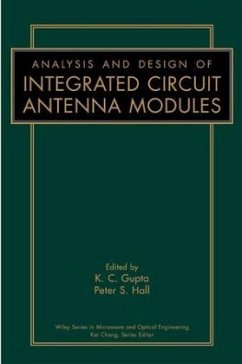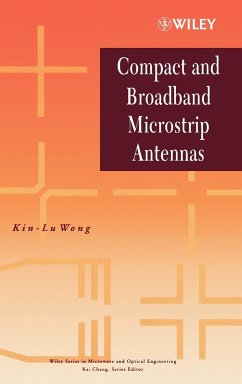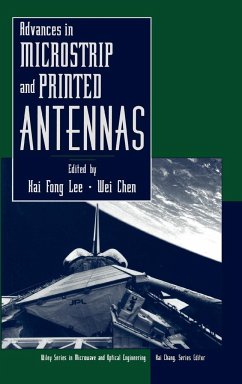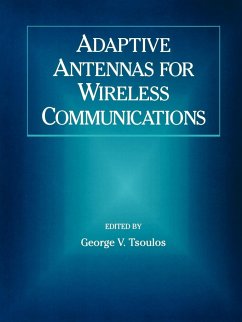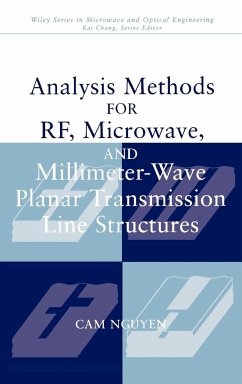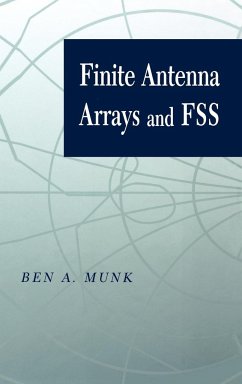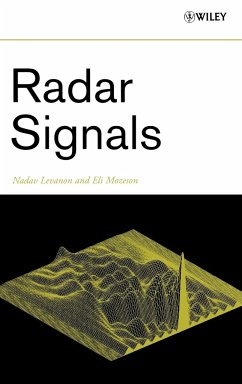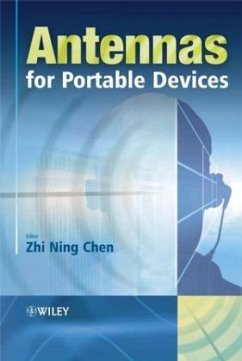
Integrated Active Antennas and Spatial Power Combining
Versandkostenfrei!
Versandfertig in über 4 Wochen
227,99 €
inkl. MwSt.

PAYBACK Punkte
114 °P sammeln!
This is the only book currently available that covers this subject. The authors piece together information from diverse areas which is essential to understand integrated and integrated active antennas. Emphasis is placed on active antennas and power combining applications, consolidating the work from numerous researchers. Early chapters lay the foundation for oscillator, antenna, array and power combining theory. Chapter five discusses important testing parameters and techniques for active antenna measurements and includes definitions for equivalent isotropic radiated power, locking gain and l...
This is the only book currently available that covers this subject. The authors piece together information from diverse areas which is essential to understand integrated and integrated active antennas. Emphasis is placed on active antennas and power combining applications, consolidating the work from numerous researchers. Early chapters lay the foundation for oscillator, antenna, array and power combining theory. Chapter five discusses important testing parameters and techniques for active antenna measurements and includes definitions for equivalent isotropic radiated power, locking gain and locking bandwidth. The last chapter sheds light on beam steering, a more recent development in active antenna arrays. Contains over 200 illustrations. Recent years have seen major progress in the development of active antennas due to advances in spatial and quasi-optical power combining techniques. These techniques have resolved problems presented by the high power requirements of many solid-state devices, and their successful implementation is responsible for the tremendous growth in research and applications, including radar and communications, electronic warfare, and low-cost sensors.
The rapid evolution of this technology has stimulated a great deal of research and numerous publications. Yet most books on the subject focus on only one of the three major components of this interdisciplinary field -- microwave circuits, antenna theory, or solid-state devices -- but do not offer a unified overview of the entire field. Integrated Active Antennas and Spatial Power Combining provides the first comprehensive treatment of the theoretical and practical elements of integrated antennas, active antennas, and spatial power combining.
The first part of the book provides all the background information necessary to understand integrated antennas, including general oscillator theory as well as antenna, array, and power combining theory. The book then classifies active antennas according to function, describes the evolution of the technology, and provides the technical tools needed to proceed confidently with antenna integration projects.
Offering many examples and useful insights, authors Julio Navarro and Kai Chang clarify the concepts behind the methods of power combining and synchronization, and examine testing parameters and techniques for active antenna measurements. They review all active integrated devices on microstrip patches, grids, notches, and other antennas; cover the application of these devices to transmitters and power combining arrays; and discuss various other active and integrated antenna components. They conclude with a chapter on beam steering, exploring both theory and potential phased-array applications for this exciting new technology. Engineers and scientists in both industry and academia, especially those involved in microwave, antennas, and solid-state devices, will find Integrated Active Antennas and Spatial Power Combining an excellent professional reference, a dependable technical guide, and a doorway to new opportunities in this dynamic field of research.
The first integrated treatment of active antennas and spatial power combining This much-awaited publication introduces the theory and practice of active antenna design and power combining, skillfully integrating areas of solid-state devices, antennas, and microwave circuits. Supplemented with 250 illustrations and numerous real-world examples, Integrated Active Antennas and Spatial Power Combining reviews the large body of work underlying current technology, discusses the latest applications, and details the steps necessary to build integrated antennas that exploit the advantages of power combining techniques. Useful for design engineers and researchers in antennas and telecommunications, and for anyone involved in microwave technology, this book
Covers the basics of the three major components of integrated antennas: circuits, solid-state devices, and antennas
Offers a broad theoretical and practical treatment--from general oscillator theory to the many applications for active antennas--focusing on the role of transmitters and power combining in many applications
Explains active antenna power combining, including methodologies for power combining and synchronization, testing parameters and techniques for active antenna measurements, and oscillator characteristics
Provides up-to-date coverage of active integrated devices on microstrip patches, grids, notches, and other antennas, and their application to transmitters and power combining arrays
Explores the promising new technology of beam steering
Cover Design: Fran Wolfson, Picture This
The rapid evolution of this technology has stimulated a great deal of research and numerous publications. Yet most books on the subject focus on only one of the three major components of this interdisciplinary field -- microwave circuits, antenna theory, or solid-state devices -- but do not offer a unified overview of the entire field. Integrated Active Antennas and Spatial Power Combining provides the first comprehensive treatment of the theoretical and practical elements of integrated antennas, active antennas, and spatial power combining.
The first part of the book provides all the background information necessary to understand integrated antennas, including general oscillator theory as well as antenna, array, and power combining theory. The book then classifies active antennas according to function, describes the evolution of the technology, and provides the technical tools needed to proceed confidently with antenna integration projects.
Offering many examples and useful insights, authors Julio Navarro and Kai Chang clarify the concepts behind the methods of power combining and synchronization, and examine testing parameters and techniques for active antenna measurements. They review all active integrated devices on microstrip patches, grids, notches, and other antennas; cover the application of these devices to transmitters and power combining arrays; and discuss various other active and integrated antenna components. They conclude with a chapter on beam steering, exploring both theory and potential phased-array applications for this exciting new technology. Engineers and scientists in both industry and academia, especially those involved in microwave, antennas, and solid-state devices, will find Integrated Active Antennas and Spatial Power Combining an excellent professional reference, a dependable technical guide, and a doorway to new opportunities in this dynamic field of research.
The first integrated treatment of active antennas and spatial power combining This much-awaited publication introduces the theory and practice of active antenna design and power combining, skillfully integrating areas of solid-state devices, antennas, and microwave circuits. Supplemented with 250 illustrations and numerous real-world examples, Integrated Active Antennas and Spatial Power Combining reviews the large body of work underlying current technology, discusses the latest applications, and details the steps necessary to build integrated antennas that exploit the advantages of power combining techniques. Useful for design engineers and researchers in antennas and telecommunications, and for anyone involved in microwave technology, this book
Covers the basics of the three major components of integrated antennas: circuits, solid-state devices, and antennas
Offers a broad theoretical and practical treatment--from general oscillator theory to the many applications for active antennas--focusing on the role of transmitters and power combining in many applications
Explains active antenna power combining, including methodologies for power combining and synchronization, testing parameters and techniques for active antenna measurements, and oscillator characteristics
Provides up-to-date coverage of active integrated devices on microstrip patches, grids, notches, and other antennas, and their application to transmitters and power combining arrays
Explores the promising new technology of beam steering
Cover Design: Fran Wolfson, Picture This



